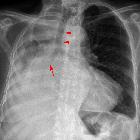radiation-induced lung cancer
Radiation-induced lung cancers are a potential long-term complication of radiotherapy to the chest.
Besides lung cancer, sarcomas (osteosarcomas are the most common arising from the irradiated bones, and malignant fibrous histiocytomas the most frequently arising from the soft tissues), breast cancers, malignant pleural mesothelioma, and esophageal cancers are also potential induced malignancies in those patients receiving radiotherapy to the chest .
Epidemiology
They have been reported as a rare late complication of radiation therapy in both post-operative breast cancer and Hodgkin lymphoma patients. These occur 5-10 years (or later) after treatment .
There appears to be increased risk of lung cancer in these patients if they also smoke tobacco .
As technology has made radiotherapy more precise with the highly conformal therapies, treatments in the last decades have minimized the incidental delivery of radiation to normal tissues. Since long-term survival for oncology patients has improved, the impact of these changes over the incidence of radiation-induced cancers is still to be seen .
Radiographic features
Besides location within the irradiated field , there are no other specific imaging features of the tumors themselves that differ radiation-induced from the sporadic lung cancers. Please refer to the parental article on lung cancer for further details.
Siehe auch:
und weiter:

 Assoziationen und Differentialdiagnosen zu strahleninduziertes Lungenkarzinom:
Assoziationen und Differentialdiagnosen zu strahleninduziertes Lungenkarzinom:
